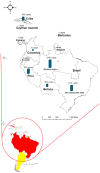A Comprehensive Review of the Neglected and Emerging Oropouche Virus
- PMID: 40143366
- PMCID: PMC11945866
- DOI: 10.3390/v17030439
A Comprehensive Review of the Neglected and Emerging Oropouche Virus
Abstract
Oropouche virus (OROV) is a neglected and emerging arbovirus that infects humans and animals in South and Central America. OROV is primarily transmitted to humans through the bites of infected midges and possibly some mosquitoes. It is the causative agent of Oropouche fever, which has high morbidity but low mortality rates in humans. The disease manifests in humans as high fever, headache, myalgia, arthralgia, photophobia, and, in some cases, meningitis and encephalitis. Additionally, a recent report suggests that OROV may cause fetal death, miscarriage, and microcephaly in newborns when women are infected during pregnancy, similar to the issues caused by the Zika virus (ZIKV), another mosquito-borne disease in the same regions. OROV was first reported in the mid-20th century in the Amazon basin. Since then, over 30 epidemics and more than 500,000 infection cases have been reported. The actual case numbers may be much higher due to frequent misdiagnosis, as OROV infection presents similar clinical symptoms to other co-circulating viruses, such as dengue virus (DENV), chikungunya virus (CHIKV), ZIKV, and West Nile virus (WNV). Due to climate change, increased travel, and urbanization, OROV infections have occurred at an increasing pace and have spread to new regions, with the potential to reach North America. According to the World Health Organization (WHO), over 10,000 cases were reported in 2024, including in areas where it was not previously detected. There is an urgent need to develop vaccines, antivirals, and specific diagnostic tools for OROV diseases. However, little is known about this surging virus, and no specific treatments or vaccines are available. In this article, we review the most recent progress in understanding virology, transmission, pathogenesis, diagnosis, host-vector dynamics, and antiviral vaccine development for OROV, and provide implications for future research directions.
Keywords: Oropouche virus; biting midge; host factors; pathogenesis.
Conflict of interest statement
All authors declare no conflicts of interest.
Figures




References
-
- WHO Oropouche Virus Disease—Region of the Americas. 2024. [(accessed on 17 February 2025)]. Available online: https://www.who.int/emergencies/disease-outbreak-news/item/2024-DON530. - PubMed
-
- CDC CDC Oropouche Current Year Data 2025. [(accessed on 17 February 2025)]; Available online: https://www.cdc.gov/oropouche/data-maps/current-year-data.html.
Publication types
MeSH terms
Substances
Supplementary concepts
LinkOut - more resources
Full Text Sources

